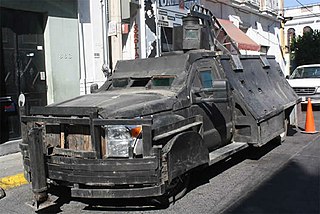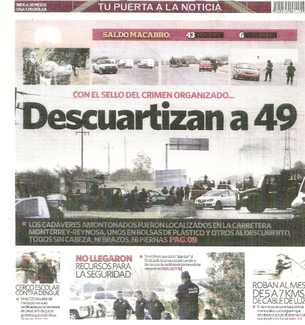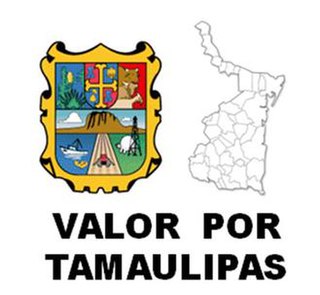
Osiel Cárdenas Guillén is a Mexican drug lord and the former leader of the Gulf Cartel and Los Zetas. Originally a mechanic in Matamoros, Tamaulipas, he entered the cartel by killing Juan García Abrego's friend and competitor Salvador Gómez, after the former's arrest in 1996. As confrontations with rival groups heated up, Osiel Cárdenas sought and recruited over 30 deserters from the Grupo Aeromóvil de Fuerzas Especiales to form the cartel's armed wing. Los Zetas served as the hired private mercenary army of the Gulf Cartel.
A drug cartel is a criminal organization composed of independent drug lords who collude with each other in order to improve their profits and dominate the illegal drug trade. Drug cartels form with the purpose of controlling the supply of the illegal drug trade and maintaining prices at a high level. The formations of drug cartels are common in Latin American countries. Rivalries between multiple drug cartels cause them to wage turf wars against each other.

Los Zetas is a Mexican criminal syndicate and terrorist organization, known as one of the most dangerous of Mexico's drug cartels. They are known for engaging in brutally violent "shock and awe" tactics such as beheadings, torture, and indiscriminate murder. While primarily concerned with drug trafficking, the organization also runs profitable sex and gun rackets. Los Zetas also operate through protection rackets, assassinations, extortion, kidnappings and other illegal activities. The organization is based in Nuevo Laredo, Tamaulipas, directly across the border from Laredo, Texas. The origins of Los Zetas date back to the late 1990s, when commandos of the Mexican Army deserted their ranks and began working as the enforcement arm of the Gulf Cartel. In February 2010, Los Zetas broke away and formed their own criminal organization, rivalling the Gulf Cartel.

The Gulf Cartel is a criminal syndicate and drug trafficking organization in Mexico, and perhaps one of the oldest organized crime groups in the country. It is currently based in Matamoros, Tamaulipas, directly across the U.S. border from Brownsville, Texas.

The Mexican drug war is an ongoing asymmetric low-intensity conflict between the Mexican government and various drug trafficking syndicates. When the Mexican military intervened in 2006, the government's main objective was to reduce drug-related violence. The Mexican government has asserted that their primary focus is dismantling the cartels and preventing drug trafficking. The conflict has been described as the Mexican theater of the global war on drugs, as led by the United States federal government.

Sandra Ávila Beltrán is a Mexican drug lord, dubbed "La Reina del Pacífico" by the media. She was arrested on September 28, 2007, and was charged with organized crime and conspiracy to drug trafficking. Some charges were later dropped but she was still held on possession of illegal weapons and money laundering, pending her extradition to the United States. On August 10, 2012, she was extradited to the United States to answer to criminal charges by the U.S. government.
The timeline of some of the most relevant events in the Mexican drug war is set out below. Although violence between drug cartels had been occurring for three decades, the Mexican government held a generally passive stance regarding cartel violence through the 1980s and early 2000s.

La Familia Michoacana, La Familia, is a Mexican drug cartel and organized crime syndicate based in the Mexican state of Michoacán. They are known to produce large amounts of methamphetamine in clandestine laboratories in Michoacan. Formerly allied to the Gulf Cartel—as part of Los Zetas—it split off in 2006. The cartel was founded by Carlos Rosales Mendoza, a close associate of Osiel Cárdenas. The second leader, Nazario Moreno González, known as El Más Loco, preached his organization's divine right to eliminate enemies. He carried a "bible" of his own sayings and insisted that his army of traffickers and hitmen avoid using the narcotics they produce and sell. Nazario Moreno's partners were José de Jesús Méndez Vargas, Servando Gómez Martínez and Enrique Plancarte Solís, each of whom has a bounty of $2 million for his capture, and were contesting the control of the organization.
This is a list of Mexico's 37 most-wanted drug lords as published by Mexican federal authorities on 23 March 2009. According to a BBC Mundo Mexico report, the 37 drug lords "have jeopardized Mexico national security."

A narco tank, also called rhino trucks or monstruos, is a type of improvised fighting vehicle used by drug cartels. The vehicles are primarily civilian trucks with improvised vehicle armour, which adds operational mobility, tactical offensive, and defensive capabilities when fighting law enforcement or rivals during drug trafficking activities.

The Apodaca prison riot occurred on 19 February 2012 at a prison in Apodaca, Nuevo León, Mexico. Mexico City officials stated that at least 44 people were killed, with another twelve injured. The Blog del Narco, a blog that documents events and people of the Mexican Drug War anonymously, reported that the actual (unofficial) death toll may be more than 70 people. The fight was between Los Zetas and the Gulf Cartel, two drug cartels that operate in northeastern Mexico. The governor of Nuevo León, Rodrigo Medina, mentioned on 20 February 2012 that 30 inmates escaped from the prison during the riot. Four days later, however, the new figures of the fugitives went down to 29. On 16 March 2012, the Attorney General's Office of Nuevo León confirmed that 37 prisoners had actually escaped on the day of the massacre. One of the fugitives, Óscar Manuel Bernal alias La Araña, is considered by the Mexican authorities to be "extremely dangerous," and is believed to be the leader of Los Zetas in the municipality of Monterrey. Some other fugitives were also leaders in the organization.

The Jalisco New Generation Cartel or CJNG, formerly known as Los Mata Zetas, is a Mexican organized crime syndicate based in Jalisco which is headed by Nemesio Oseguera Cervantes, one of the world's most-wanted drug lords. The cartel has been characterized by its aggressive use of extreme violence and its public relations campaigns. Although the CJNG is particularly known for diversifying into various types of criminal rackets, drug trafficking remains its most profitable activity. The cartel has also been noted for cannibalizing some of its victims, sometimes during the training of new sicarios or cartel members, as well as using drones and rocket-propelled grenades to attack its enemies.
During the ongoing Mexican drug war, drug cartels use propaganda through media and scare tactics to gain more control of its people and in many cases corrupting the government. The main goals are to glorify actions of the drug cartels and their lifestyle, gain control of the Mexican society to the highest extent possible, and to recruit new, educated, high-class members to increase their power even further. These drug cartels' use of propaganda and scare tactics are used in precise, complex, and clever ways to get the most out of every action, resulting in their enormous power.
The 2012 Nuevo Laredo massacres were a series of mass murder attacks between the allied Sinaloa Cartel and Gulf Cartel against Los Zetas in the border city of Nuevo Laredo, Tamaulipas, across the U.S.-Mexico border from Laredo, Texas. The drug-violence in Nuevo Laredo began back in 2003, when the city was controlled by the Gulf Cartel. Most media reports that write about the Mexican Drug War, however, point to 2006 as the start of the drug war. That year is a convenient historical marker because that's when Felipe Calderón took office and carried out an aggressive approach against the cartels. But authors like Ioan Grillo and Sylvia Longmire note that Mexico's drug war actually began at the end of Vicente Fox's administration in 2004, when the first major battle took place in Nuevo Laredo between the Sinaloa Cartel and Los Zetas, who at that time worked as the armed wing of the Gulf Cartel.

El Narco: Inside Mexico's Criminal Insurgency is a non-fiction book of the Mexican drug war written by Ioan Grillo. In El Narco, Grillo takes a close look at the Mexican drug trade, starting with the term "El Narco", which has come to represent the vast, faceless criminal network of drug traffickers who cast a murderous shadow over Mexico. The book covers the frontline of the Mexican drug war. It seeks to trace the origins of the illegal drug trade in Mexico, the recent escalation of violence, the human cost of the drug trade and organized crime in the country. The book takes a critical stance on the unsuccessful efforts made by the Mexican government and the United States to confront the violence and its causes.

The Cadereyta Jiménez massacre occurred on the Fed 40 on 12–13 May 2012. Mexican officials stated that 49 people were decapitated and mutilated by members of Los Zetas drug cartel and dumped by a roadside near the city of Cadereyta Jiménez in northern Mexico. The Blog del Narco, a blog that documents events and people of the Mexican Drug War anonymously, reported that the actual (unofficial) death toll may be more than 68 people. The bodies were found in the town of San Juan in the municipality of Cadereyta Jiménez, Nuevo León at about 4 a.m. on a non-toll highway leading to Reynosa, Tamaulipas. The forty-three men and six women killed had their heads, feet, and hands cut off, making their identification difficult. Those killed also bore signs of torture and were stuffed in plastic bags. The arrested suspects have indicated that the victims were Gulf Cartel members, but the Mexican authorities have not ruled out the possibility that they were U.S.-bound migrants. Four days before this incident, 18 people were found decapitated and dismembered near Mexico's second largest city, Guadalajara.
In 2011 and 2012, during the Mexican drug war, hundreds of people were killed in massacres by rival drug cartels who were fighting for power and territory. These organized-crime syndicates were grappling for control over the drug corridors to the United States, the drug markets in local cities, extortion rackets, and human smuggling. Massacres occurred in the states of Veracruz, Sinaloa, Jalisco, Tamaulipas and Nuevo León.

Anabel Hernández García is a Mexican journalist and author, known for her investigative journalism of Mexican drug trafficking and into the alleged collusion between US government officials and drug lords. She has also written about slave labor, sexual exploitation, and abuse of government power. She won the Golden Pen of Freedom Award 2012, which is presented annually by the World Association of Newspapers and News Publishers.

Borderland Beat is an English language news blog that reports on the Mexican Drug War. The blog was started in 2009 by an anonymous individual using the pseudonym Buggs. Borderland Beat's reporters are mostly based in the U.S. and Mexico. Their main focus is to provide English coverage of the drug war in Mexico, by creating analysis and research material about drug cartels, criminal figures, and the effects on the ongoing drug war, as well as translating Spanish articles into English.

Valor por Tamaulipas is a Facebook page that covers security updates in the Mexican state of Tamaulipas. It was founded by an anonymous user on 1 January 2012, and its goal is to share information with other social media users on drug-related violence and risk situations all across the state. With over 515,000 likes on Facebook, Valor por Tamaulipas routinely posts messages and photos of crime scenes on its page. In a country where many journalists have been assassinated for writing about drug trafficking and organized crime, the page survives under anonymity, but it has not been immune to threats.













